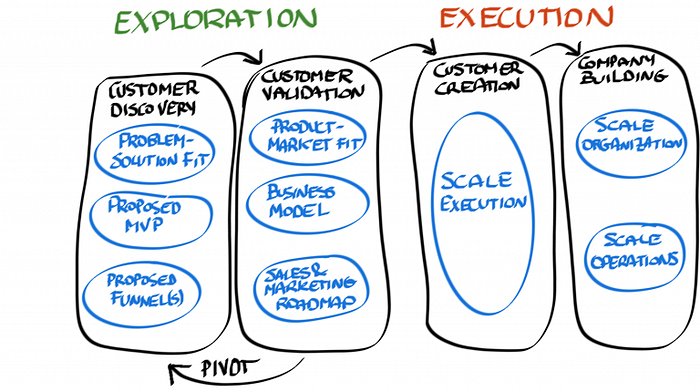Unlocking Customer Needs: Building Generative AI Solutions that Delivers Real Value

👀TL;DR👀
Generative AI projects often fail due to a lack of customer understanding. Use the Jobs to be Done framework, form diverse teams, and embrace a lean methodology to build impactful AI solutions that deliver real value and avoid project abandonment.
The hype around Generative AI is undeniable, but Gartner predicts a stark reality: 30% of Generative AI projects will be abandoned by the end of 2025. Why? Because many businesses are rushing into implementation based on what customers say they want rather than truly understanding their customers’ needs. This is where the “Jobs to be Done” (JTBD) framework proves invaluable, helping you understand the underlying motivations and goals of your customers. Furthermore, this helps prioritizing AI initiatives that will have the biggest impact.
Identifying the “Jobs” We’re Solving
The “Jobs to be Done” (JTBD) framework, popularized by Clayton Christensen, provides a customer-centric approach that helps with identifying the underlying tasks or “jobs” that customers are trying to accomplish in a given situation. By understanding the specific steps involved in these “jobs,” we can pinpoint key pain points, challenges, and desired outcomes that our AI solution should address.
JTBD uncovers the emotional and social dimensions of customer jobs, ensuring that the solution resonates with users on a personal level. For example, consider a busy professional juggling meetings, deadlines, and personal commitments. Their “job-to-be-done” could be:
“I need a way to effortlessly manage my schedule, stay on top of tasks, and avoid missing important deadlines, without adding more cognitive load to my already hectic day.”
By mapping out the specific steps involved in this “job,” we can identify potential AI solutions that help prioritize tasks, set smart reminders, or seamlessly rearrange calendars when plans change.
Building a Collaborative & Diverse Team for Success
Armed with this deep understanding of your customers’ underlying motivations and desired outcomes, we can assemble a collaborative team with diverse skill sets to deliver a AI solution tailored to their needs. By bringing together data scientists, CX researchers, subject matter experts (SMEs), and DevOps engineers, the team can tackle the problem at hand from multiple angles, resulting in more comprehensive and innovative solutions.
Furthermore, diverse teams are better equipped to identify and mitigate potential biases. Individuals from different cultural backgrounds can bring unique perspectives to data analysis and algorithm design, ensuring that AI solutions are fair and equitable for all users. By considering the needs and perspectives of a wide range of stakeholders, we can create AI products that are inclusive and truly beneficial to society.
Ultimately, by leveraging the collective knowledge and varied viewpoints of a multi-disciplinary team, organizations can more effectively navigate the complex ethical landscape of AI development and implementation. This approach not only ensures that AI solutions are technically sound, but also that they are ethically sound, fostering trust and responsible innovation.
Leveraging the Lean Product Lifecycle
The lean product lifecycle methodology, when combined with the JBTD framework, offers a powerful and customer-centric approach to product development. This methodology prioritizes rapid iteration, continuous testing, and feedback-driven enhancements, ensuring that the solution delivers tangible benefits and aligns with costumer needs.

The exploration phase is focused on understanding the core “jobs-to-be-done” to be solved and validating initial concepts with potential users to gather feedback and refine the product vision. Then, a basic version of the product with core functionalities, known as a Minimum Viable Product (MVP), is developed to test assumptions and gather valuable user insights.
Once product-market fit is achieved, the focus shifts to efficient execution. This involves implementing strategies to rapidly increase user acquisition, engagement, and retention. The product and processes are then fine-tuned to maximize performance and efficiency. Finally, a robust infrastructure and business model are built to support long-term growth and success.
Incorporating the Diffusion of Innovation theory can be incredibly valuable to further improve the outcomes of the lean product lifecycle methodology. This theory identifies different adopter categories, helping to pinpoint potential early users who are more likely to embrace a new product or service. By targeting these early adopters, businesses can gather valuable feedback and gain crucial traction for their product, driving further adoption and market penetration.
From Frustration to Solution: JTBD in Action
To truly see these principles in action, let’s consider the development of Ovid Synthesis, a comprehensive tool designed to streamline Evidence-Based Practice (EBP) and Quality Improvement (QI) initiatives across healthcare organizations (see article).

Using the JTBD framework, we discovered that healthcare professionals struggle to improve patient outcomes in a time-constrained and resource-limited environment. This led to the realization that they weren’t simply seeking a tool for research, but wanted a solution that would simplify the entire EBP/QI process, from project definition to implementation, providing support for all stages, including literature review and data analysis.
By leveraging the the lean product lifecycle methodology, we started with a MVP that provided essential features for project management, literature review, and data analysis. Crucially, we gathered continuous feedback from healthcare professionals, iteratively refining and improving the tool based on their needs.
One notable outcome of this approach was the ability to reduce duplicative research efforts across institutions by extracting actionable insights from medical literature. This highlights how AI, when thoughtfully applied, can address critical needs within healthcare and streamline workflows, ultimately improving patient care.
Building AI That Matters
In a world buzzing with AI possibilities, it’s easy to lose sight of the core problem: What do our customers truly need? By prioritizing customer needs, fostering collaboration, and embracing a lean methodology, businesses can gain a deeper understanding of their customers’ underlying motivations and desired outcomes. By embracing this customer-centric approach, we can not only avoid the pitfalls of Generative AI project abandonment, but we can also craft AI solutions that genuinely improve people’s lives.
Let’s work together to ensure that AI projects are not just innovative, but also impactful and successful. Remember, it’s not just about building AI, it’s about building AI that truly matters.
Disclaimer:
The insights presented in this blog post are the sole opinions of the author and do not represent the views of any past or current employers. The content was created with the assistance of Generative AI technology, specifically TechType Rocket, under the supervision and guidance of a human AI expert, Quentin Reul.
